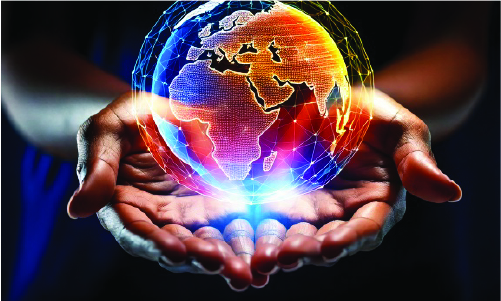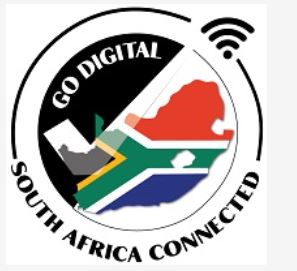- Details

Chair's Statement - Task Force on AI, Data Governance and Innovation for Sustainable Development
- Details

Chair's Statement - Digital Economy Working Group
Annexure 1: Universal and Equitable Digital Inclusion Framework
Annexure 2 DPI Public Value Measurement Framework
Annexure 3 Guidelines for Integrated Governance of DPI
Annexure 6: Toolkit to Reduce Inequalities Connected to the Use of AI
- Details
- Details

Showcase Your Innovation on the Global Stage
Cape Town, South Africa | September 26-29, 2025
About the Challenge
The G20 Digital Innovation Alliance (G20-DIA) is a ground-breaking initiative by the Digital Economy Working Group (DEWG) of the Group of 20, established to identify, recognise, and enable the adoption of innovative digital technologies developed by startups from G20 countries and invited guest nations.
Our mission is to address humanity's most pressing needs across six critical sectors through cutting-edge digital solutions that can create global population-scale impact, reduce the digital divide, and enable sustainable and inclusive techno-socio-economic development.
The G20-DIA Summit will bring together top-nominated startups from each theme area to showcase their solutions to a global community of investors, mentors, corporates, and government stakeholders on the sidelines of the DEWG meeting in Cape Town.
Six Innovation Themes
1. Fintech
Transforming Financial Services
We seek innovative digital solutions that transform financial services and improve money management, access, and transfer. Your entry should address financial inclusion, streamline payments, enhance transaction security, improve credit access, or reimagine banking services.
Focus Areas:
- Reducing barriers to financial services
- Lowering costs for underserved populations
- Creating new possibilities for financial access
- Demonstrating regulatory compliance and security
- Showing scalability potential in the fintech landscape
2. Digital Platforms and AI Tools
Connecting Communities Through Technology
This stream focuses on innovative solutions that create value by connecting multiple user groups in virtual marketplaces. Develop scalable platforms that address market inefficiencies, create new digital ecosystems, or transform industries through technology-enabled connections.
Focus Areas:
- Reducing transaction costs
- Increasing market access
- Enabling new forms of collaboration
- Addressing challenges in underserved markets
- Demonstrating clear value proposition and scalability
3. Secured Digital Infrastructure
Strengthening Our Digital Foundation
We're looking for solutions that strengthen cybersecurity, data protection, and system resilience in our connected ecosystem. Showcase technologies that protect digital assets, safeguard information, secure networks, or ensure business continuity during threats.
Focus Areas:
- Enhancing digital trust
- Enabling safe adoption of emerging technologies
- Creating accessible security measures for SMEs
- Protecting against critical security challenges
- Demonstrating business value through security
4. Circular Economy
Extending Technology Lifecycles
This stream seeks digital solutions that extend tech product lifecycles and reduce e-waste. Show how your innovations enable sustainable practices such as refurbishment, component recovery, equipment sharing, or resource optimization.
Focus Areas:
- Demonstrating clear business value
- Addressing environmental challenges of linear consumption
- Embracing circular principles within ICT supply chains
- Helping other industries adopt sustainable practices
- Creating measurable environmental impact
5. Innovation for Development (Social Impact)
Technology for Social Good
We seek digital solutions addressing critical social challenges in agriculture, healthcare, and education. Develop technologies that improve agricultural productivity, enhance healthcare access, or transform educational delivery while creating both social impact and business value.
Focus Areas:
- Solving specific problems in agriculture, healthcare, or education
- Ensuring accessibility and local adaptability
- Demonstrating scalability potential
- Addressing needs in underserved or resource-constrained environments
- Creating measurable social impact
6. Innovation for Connectivity
Bridging the Digital Divide
This stream focuses on digital solutions that bridge the digital divide and enhance network infrastructure for underserved communities. Develop technologies that improve internet access, strengthen telecommunications, or create affordable connectivity options.
Focus Areas:
- Overcoming barriers to digital inclusion
- Creating sustainable business models
- Demonstrating scalability and adaptability
- Serving remote or resource-constrained settings
- Building infrastructure for the future
Timeline & Key Dates
June 30, 2025 Final deadline for member states to submit nominations
July 15, 2025 Top 1 startup from each of the 6 sectors submitted by G20 and guest countries
July - August 2025 Virtual Accelerator Programme for selected startups
September 25, 2025 Arrival at the G20 SME25 Summit in Cape Town
September 26-29, 2025 G20 SME25 Summit - Multi-day programme featuring innovation showcase, networking, panel discussions, and pitching sessions
September 29, 2025 Award Ceremony recognizing top three digital innovations in each category, followed by Gala Dinner
Evaluation Criteria
Startups will be evaluated based on a comprehensive set of criteria:
- Team - Strength and expertise of the founding team
- Technology/Innovation - Uniqueness and technical excellence of the solution
- Revenue - Current financial performance and revenue streams
- Market Size - Addressable market and growth potential
- Business Model - Viability and sustainability of the business approach
- Scalability - Ability to grow and expand the solution
- Sustainability - Long-term viability and environmental considerations
- Competitive Advantage - Unique positioning in the market
- Qualitative Factors - Overall impact and potential for success
Value Proposition for Innovators
Global Platform
Showcase your solution to a worldwide audience of investors, mentors, corporates, and government stakeholders.
Expert Mentorship
Receive intensive guidance from renowned public and private sector experts and mentors throughout the process.
Strategic Partnerships
Gain access to a network of corporates and strategic partners for potential collaboration and growth opportunities.
Investor Access
Meet and pitch directly to various investors actively seeking innovative digital solutions.
Global Recognition
Get featured in the official G20-DIA eBook and gain international recognition for your innovation.
Award Opportunities
Compete for prestigious recognition as one of the top three innovations in your category.
Eligibility Requirements
Startup Criteria
- Your startup must have launched the product in the market and have initial traction
- Startup should not be more than 10 years old
- Must be headquartered in your home country
- Will be evaluated based on innovation and product criteria outlined above
Who Should Apply
- Students from colleges or schools with innovative digital solutions
- Entrepreneurs and working professionals developing cutting-edge technologies
- Faculty and researchers with market-ready innovations
- Aspiring startup founders with viable digital solutions
Summit Highlights
Digital Innovation Showcase Pavilion
Dedicated space for startups to demonstrate their solutions to attendees
Global Speakers Program
Industry leaders, unicorns, governments, and corporates sharing insights and expertise
Investor Engagement
Direct access to investors through dedicated pitching sessions and networking opportunities
Networking Events
Exclusive dinners and networking opportunities with key stakeholders from across the global innovation ecosystem
Awards Recognition
Prestigious ceremony recognizing the top three digital innovations in each category
Dedicated Platform & App
Specialized technology platform to maximize engagement and connections during the event
The Selection Process
Each participating G20 country and invited guest nation will:
- Identify relevant problem statements across the six priority themes
- Establish their own jury and selection criteria
- Conduct outreach events, thematic sessions, workshops, and expert panels
- Select their top six innovations (one for each theme)
- Nominate key stakeholders from their innovation ecosystem to accompany the startups
Selected startups will pitch their solutions to a diversified jury committee comprising academia, corporates, mentors, ministries, and investors recognized under each theme.
Apply Now
Ready to showcase your innovation on the global stage? Join startups from around the world in addressing humanity's most pressing challenges through digital innovation.
Important Links:
- G20 SME Challenge Registration page: http://bit.ly/3SW2pwB
- Visa Applications: https://ehome.dha.gov.za/epermit/home
- Official G20 Website: www.g20.org
Follow the Journey: #G20SouthAfrica | #ReKaofela
The G20 Digital Innovation Alliance represents a unique opportunity to connect with the global innovation ecosystem, showcase your solution to key stakeholders, and contribute to meaningful global economic growth while addressing the digital divide.
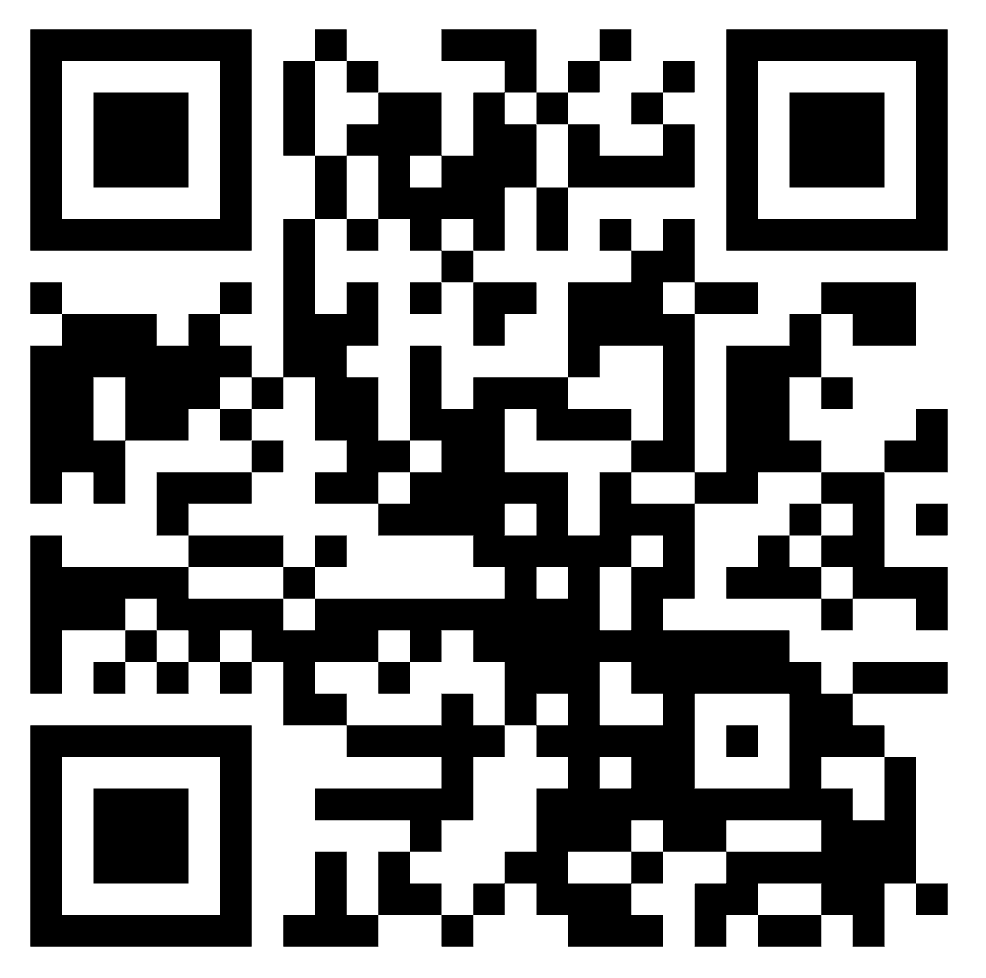
- Details
DCDT CONTACT DETAILS
|
PHYSICAL ADDRESS |
POSTAL ADDRESS |
SWITCHBOARD |
|
|
iParioli Office Park
1166 Park Street
Hatfield
Pretoria
0001
|
Private Bag X860
Pretoria
0001
|
Tel: +27(0)12 427 8000
Fax: +27(0)12 427 8110
|
GPS coordinates ![]() -25.7486807,28.2359998
-25.7486807,28.2359998
|
MINISTER’S OFFICE |
DEPUTY MINISTER’S OFFICE |
DIRECTOR-GENERAL’S OFFICE |
|
Head of Office: |
Chief Director: DGO
Name: Ms Pari Pillay
Tel: +27 (12) 427 8160
Cell: +27 (79) 889 0130
Email: This email address is being protected from spambots. You need JavaScript enabled to view it.
|
|
|
Outreach and Stakeholder Relations Officer:
Name: Thabo Shingange Tel: +27 79 636 6992 Email: TThis email address is being protected from spambots. You need JavaScript enabled to view it. |
Private Secretary:
Name : Ms. Zanele Nkonyane
Tel: +27 64 816 6636
|
Personal Assistant to DG:
Name: Ms Tebogo Mathebula
Tel: +27 (12) 427 8167
Cell: +27 (82) 819 3590
|
Media Liason Officer and Spokesperson: Name: Mr Kwena Moloto Tel: +27 60 902 7077 Email: This email address is being protected from spambots. You need JavaScript enabled to view it. |
Parliamentary & Cabinet Liason Officer:
Name: Ms. Xolisa Mnyute Tel: +27 66 044 6412 Email: This email address is being protected from spambots. You need JavaScript enabled to view it. |
Information Officer:
Name: Ms Nonkqubela Jordan-Dyani
Tel: +27 (12) 427 8031/ 8000
|
|
Outreachar & Stakeholder Liason Officer: |
Deputy Information Officer:
Name: Mr Luyanda Ndlovu
Tel: +27 (12) 427 8598
Email: This email address is being protected from spambots. You need JavaScript enabled to view it.
|
- Details
SA CONNECT
OVERVIEW
SA Connect is the implementation of the national broadband policy that was approved by Cabinet in 2013. SA Connect seeks to meet the technology goals of the National Development Plan of creating an inclusive information society and position the government to play an enabling role in the provision of broadband to the number of underserved district municipalities thereby bridge broadband connectivity gaps. This would be achieved by the pooling of public sector demand and procuring of high-capacity and future-proof network capacity at more affordable rates to address public sector broadband requirements. And in the process stimulating network builds by the network operators by reducing the associated investment risk, by ensuring demand. Due to the magnitude of the project, the programme was divided into two phases, phase one and phase two.
PHASE 1
In terms of phase one, the programme initially aimed at connecting 6135 government facilities, which include all schools, health facilities, post offices, police stations and government offices, in the eight rural district municipalities, to broadband services. Phase one scope was subsequently reduced to 970 government facilities due to budget constraints.
Government has mandated the State Information Technology Agency (SITA) and Broadband Infraco (BBI) to provide the end-to-end broadband services to the 970 government facilities in the eight identified district municipalities, namely (1) Dr Kenneth Kaunda in North West, (2) Thabo Mofutsanyane in Free State, (3) OR Tambo in Eastern Cape, (4) Vhembe in Limpopo, (5) Gert Sibande in Mpumalanga, (6) Pixley ka Seme in Northern Cape, (7) uMgungundlovu and (8) uMzinyathi in KZN. The remaining 5165 facilities that were not provided with broadband service due to the limited budget allocation for the programme will be transferred to phase two of the programme.
Breakdown of Phase 1 connected government facilities: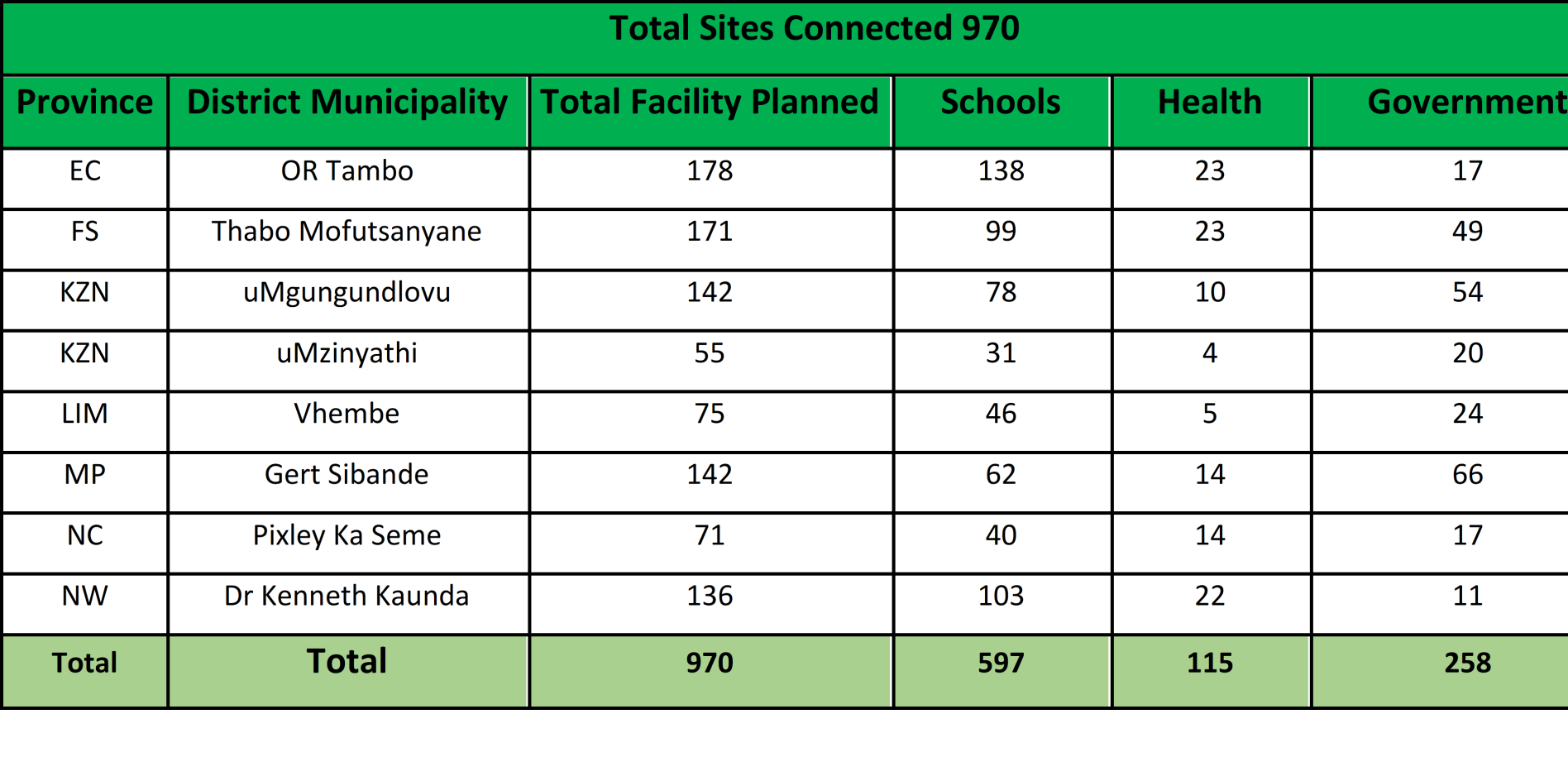
Maps of the 8 District Municipalities:
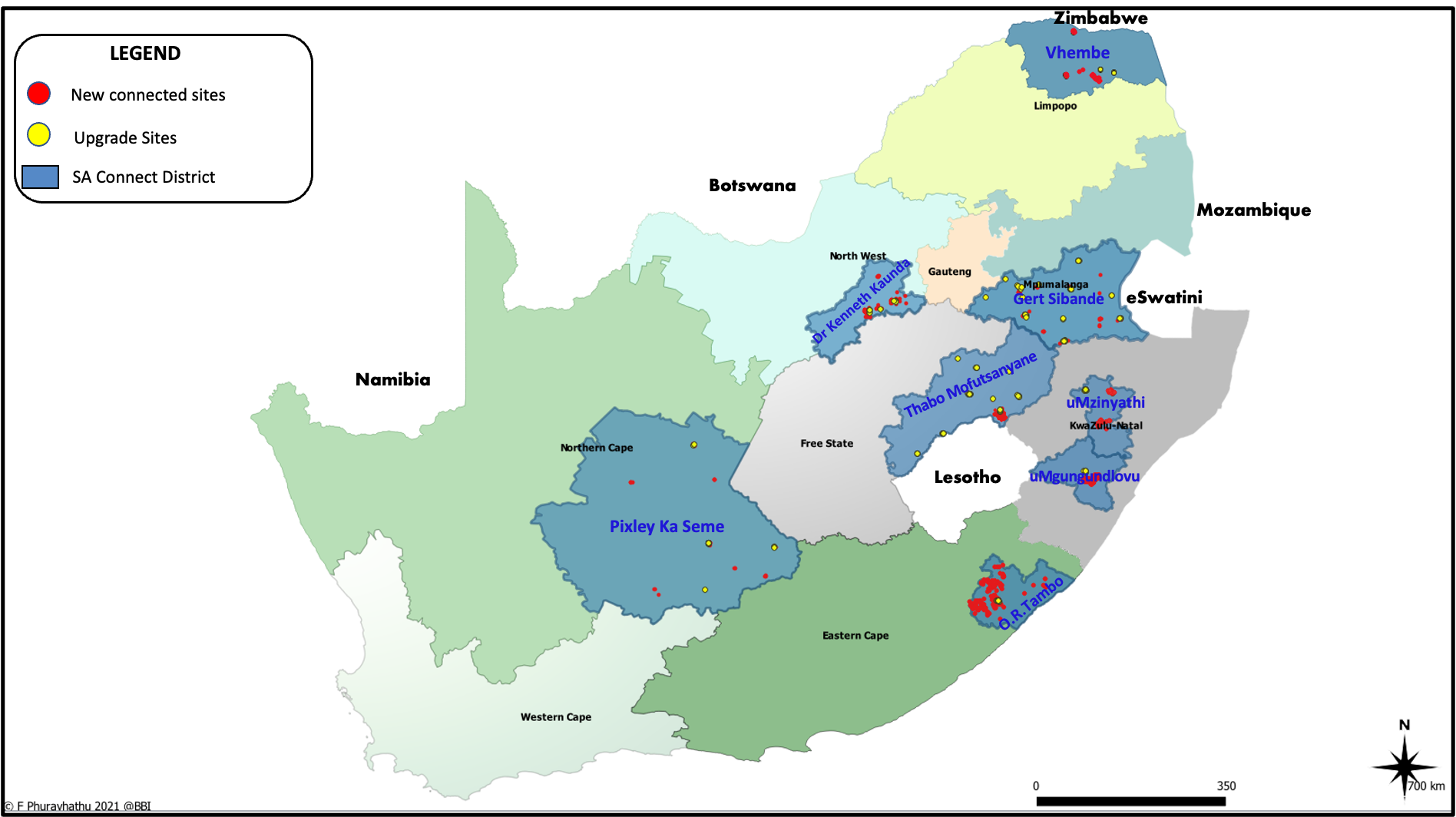
SA CONNECT PHASE 2 HITS CRITICAL MILESTONES
While broadband is seen as a powerful tool for economic and social development and for effective and efficient government service delivery, South Africa is still challenged by issues of broadband accessibility, usability, and affordability. South Africa’s terrestrial fibre routes are in excess of 200 000 kilometres. Through Phase 2 of SA Connect programme, additional 1180 kilometres of terrestrial fibre is planned to be deployed to enable coverage of about 5.5 million households.
According to ICASA State of ICT report released in 2024:
- Fibre-to-the-home/building internet subscriptions increased from 1 365 429 in 2022 to 1 488 483 in 2023.
- National population coverage for 3G stood at 99.40% in 2023. National population coverage for 4G/LTE stood at 80%. National 5G population coverage increased from 20% in 2022 to 38.42% in 2023, marking a substantial increase in a single year.
- At the national level, there is 78.9% of universal connectivity, with 82.1% regarded as meaningful connectivity in the ITU database for 2024 report.
- In 2021, 69.4% of households nationally had access to the Internet using mobile devices, with the majority of this access accounted for by Households living in urban areas at 73.3%, and metropolitan areas accounting for 73.4%. Mobile devices are also the most used means of accessing the Internet by Households in rural areas, at 59.2%.
SA Connect is a national broadband policy and strategy approved by the Cabinet in 2013. Its aim is to galvanize the public and private sectors' capability, resources, and energy to realize a bold vision of a connected society through accessible, quality, and affordable broadband connectivity. Due to its scale and complexity, the programme was divided into phases: Phase 1, the pilot, and Phase 2.
Phase 1 was implemented in 2017 through an “anchor tenant” approach, providing broadband connectivity to schools, health facilities, and other government facilities in 8 selected districts to stimulate private sector investment in broadband infrastructure.
In 2022, the Cabinet approved the revised SA Connect Phase 2 model to roll out broadband infrastructure to enable connectivity countrywide. The key objective of the revised SA Connect model is to achieve 100% broadband access for all communities and Government facilities. The programme aims to connect South Africans within 36 months (2023/24 – 2025/26) at a minimum speed of 5 Megabits per second (Mbps) for households and 10 Mbps for Government facilities, including public schools and health facilities.
The revised SA Connect model, which is currently being implemented, comprises the following key interventions:
- Community and households’
- Connectivity of government facilities; and,
- Universal Service Obligations.

The SA Connect programme is expected to:
- Provide connectivity at a minimum speed of 5 Mbps for households and at 10 Megabit per second (Mbps) for government The speeds are expected to be upgraded in the future.
- Leverage universal service obligations to fund the connectivity of schools.
- Leverage national, provincial, and municipal budgets to fund government connectivity and the Universal Service Access Fund for subsidies.
- Leverage ICT infrastructure owned by non-ICT SOEs, provinces and
- Use last-mile providers and internet service providers, including local SMMEs, virtual network providers, to extend connectivity from government facilities to households and create public Wi-Fi hotspots which is inclusive of Broadband Access Fund.
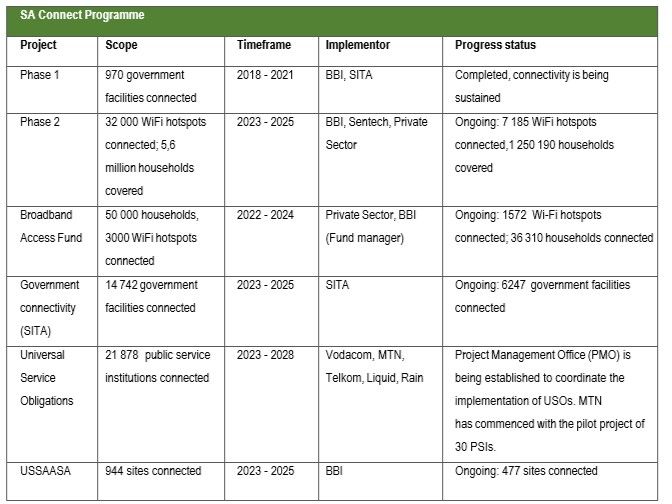
- Align with the District Delivery Model and prioritise provinces/district municipalities based on quick wins and the highest impact achievable.
Broadband Infraco and Sentech will, in conjunction with the ICT industry, particularly Small, Medium and Micro Enterprises (SMMEs), provide broadband services to South Africans, primarily through the deployment of 32 055 Wi-Fi hotspots, enabling the connectivity of 5 573 258 households over 36 months.
The table below shows the breakdown of WiFi hotspots per province:

Sentech and BBI have deployed around 7 185 Wi-Fi hotspots nationally, providing coverage for 1 250 190 households. The breakdown of the deployment of Wi-Fi hot spots per province in relation to actual targets achieved to date:
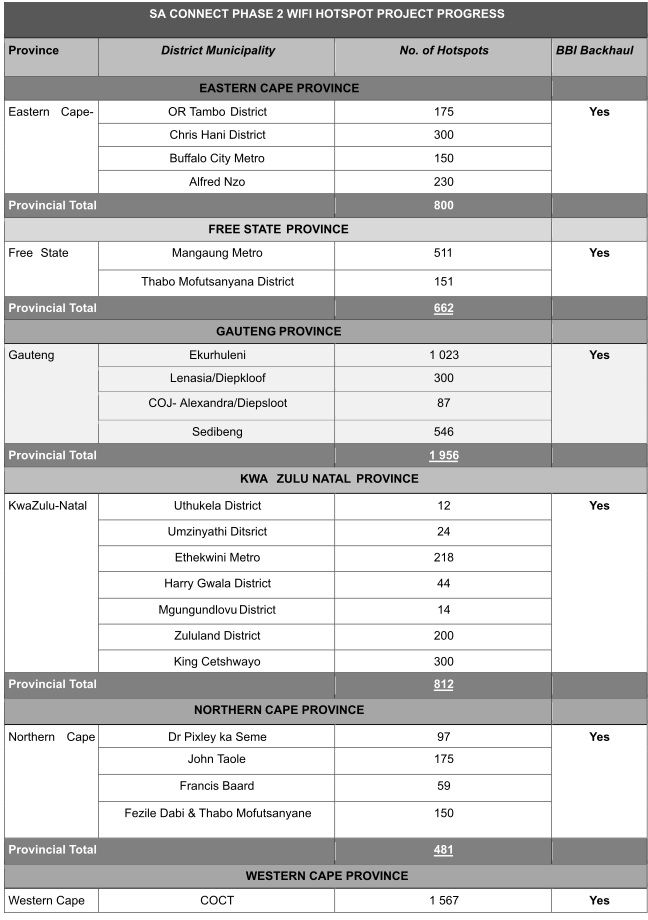
SITA has connected Government National and Provincial Departments under SA Connect phase 2. The table below highlight is the current existing sites that are on the SITA Next Generation Network (NGN) that are being sustained.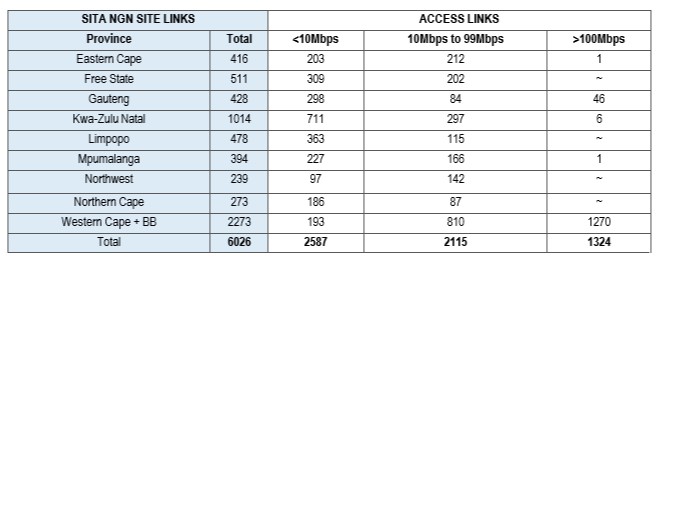
- Details
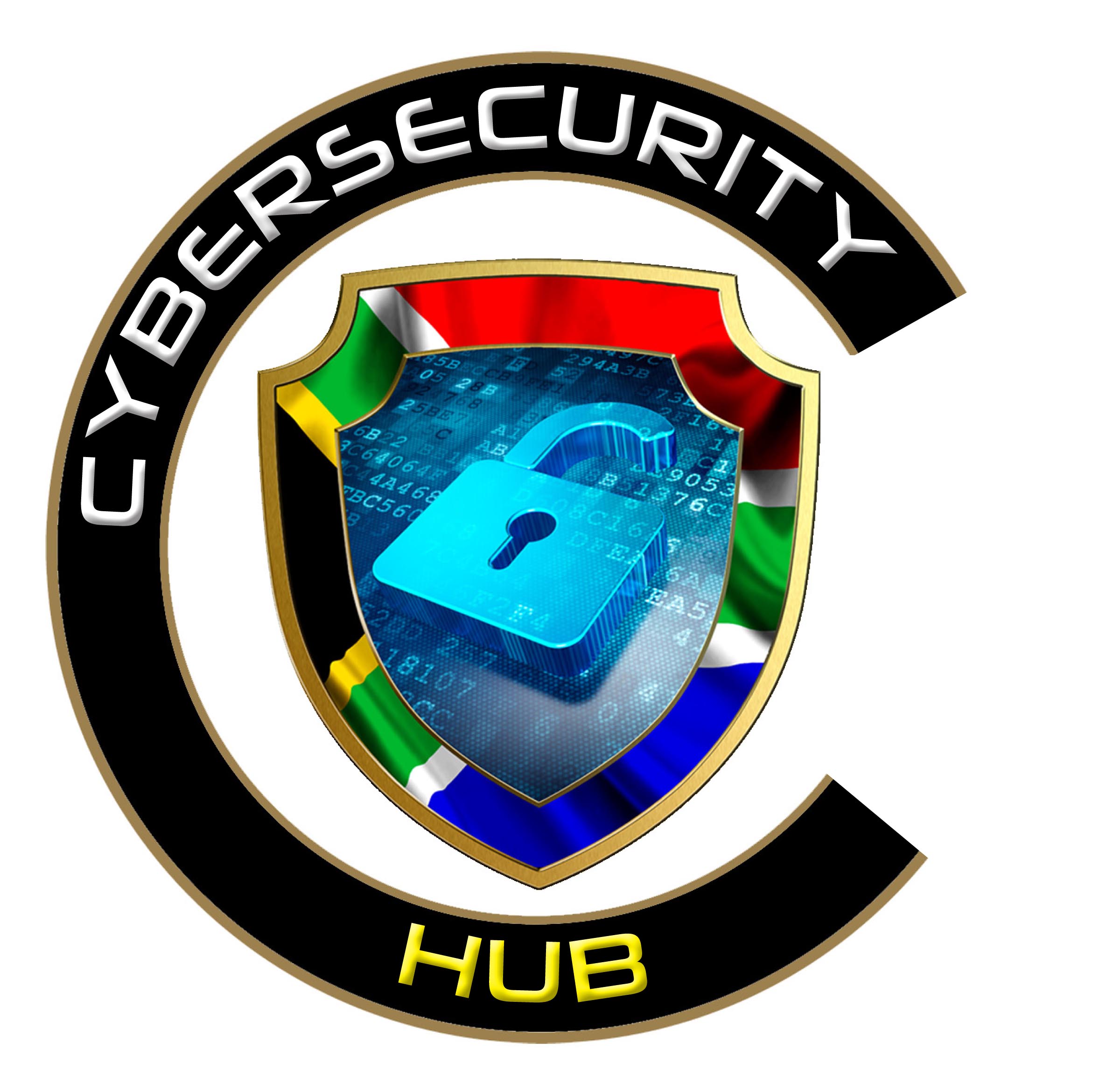 Cybersecurity Hub Project
Cybersecurity Hub Project
The Cybersecurity Hub is the national Computer Security Incident Response Team (CSIRT), established by the Department of Communications and Digital Technologies. The objective of the Cybersecurity Hub is to make Cyberspace an environment where all residents of South Africa can safely communicate, socialise, and transact in confidence. The Cybersecurity Hub works with stakeholders from government, the private sector, civil society and the public with a view to identifying and countering cybersecurity threats.
In creating the secure Cyberspace, the Cybersecurity Hub initiated Cybersecurity Awareness.
Part of the cybersecurity awareness initiatives was the development of the national cybersecurity awareness. The Awareness Portal is the repository for all Cybersecurity Awareness information and is used for the dissemination of Cybersecurity Awareness programs and information
https://www.cybersecurityhub.gov.za/cyberawareness
Other Cybersecurity Awareness initiatives include the following:
- Community Radio: Deputy Minister hosts one-hour program at GCIS studios - broadcast on approximately 65 community radio stations, approximately five million people. The first program focused on financial security, with SABRIC as a participant discussing financial security topic
- Cyber Schools Toolkit: A Cyber Safety and Awareness Toolkit for school learners was developed, in partnership with UNISA, UK government and its objectives is to promote a cybersecurity mind-set and culture through an educational toolkit
- “Qaphela Online” Newsletter: The newsletter is aimed at encouraging South African citizens to be vigilant when surfing the Internet. Various Stakeholders work with the Cybersecurity Hub in developing monthly newsletter focusing on different themes.
- Hackathon: The Cybersecurity Hub has been collaborating with a consortium of private sector organisations – including KnowBe4, TrendMicro, BCX, Bi-Technologies, Vox Telecom, NClose, Black Rhino and Bi-Tech Africa - and the University of the Western Cape’s Future-Innovation Lab and hosted a cybersecurity themed hackathon, called the Government Innovation Challenge
For more information about the project visit https://www.cybersecurityhub.gov.za
Contact Person: Kiru Pillay, This email address is being protected from spambots. You need JavaScript enabled to view it.
Page 1 of 7




